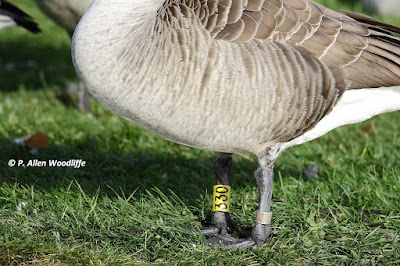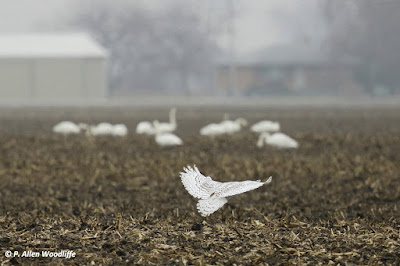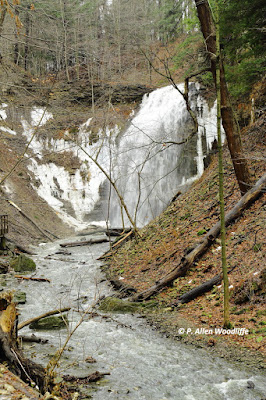Birds are frequently on the move, whether it is to their breeding grounds or their wintering ground. Of course resident species don't migrate great distances, but they may move a few kilometres. As observers in our own little part of the world, we can see these changes over the months as our lists of birds observed change. Over the past couple of weeks waterfowl, and in particular geese, have been arriving in larger numbers.
At the other end of the size scale, birds such as Horned Larks are now arriving.
But where do these birds go and how does one discover the routes they go, and distances they travel? One of the main ways is through the banding process....called 'ringing' in Europe.....that is putting lightweight aluminum bands with a specific number on it.
One of the pioneers of bird banding was Jack Miner, who had an intense interest in Canada Geese,and established the Jack Miner Bird Sanctuary near Kingsville, Ontario. He apparently wasn't the originator of banding, but certainly popularized it. His biological understanding of predator-prey relationships and the balance of nature was weak, to say the least, but that is another story. His passion for Canada Geese and establishing sanctuary for them was amazing, and his efforts to discover their migratory movements were instrumental in early conservation efforts towards wildlife in general.
The banding process has basically been the same ever since the early 1900s: put an aluminum band on a bird's leg, with an individual number imprinted on it so that if it is recovered at some point in the future, some basic data can be obtained: how old that bird might be, where it came from, where it ended up, maybe even how long it took to get from one point to another. Of course if the bird is shot, or meets its demise in some other way, the information is limited. If the bird is captured at various points along its routes over several months or years, there is an immense amount of data that can be obtained.
Over the years there have been some changes. For example put a large coloured band with its own combination of numbers and letters (called alpha-numerics) on the neck of a goose or swan, and that bird can be identified from a distance, assuming the observer has decent optical equipment. Colourful neck collars used to be quite common a few years ago, and it was typical to scan through a flock of geese or swans and see several neck collared birds....orange with white letters/numbers was the most common in this area, but sometimes you could see collars of blue, white or black. In looking through those flocks these days, one does not seem to see collars as often, in my experience.
 |
| No collars on these geese! |
That doesn't mean birds aren't being banded.....quite the contrary. There have been some creative ways to be able to follow birds. For example: Great Egrets. Since they aren't hunted, they aren't going to be shot and have the leg band turned in, and they aren't going to fly into mist nets which bird banders have set up to capture, band and release birds. Fortunately Great Egrets are large birds, so a colourful wing tag, with a visible number & letter code is sometimes used.This bird was banded at Nottawasaga, along the south shore of Georgian Bay on June 26, 2014, when it was too young to fly. I noted it along a creek just south of Petrolia, in Lambton, on September 22, 2014, so it was just a few months old. In the first photo, part of the blue tag is covered up, but the second photo show the code more clearly: 95K
Last fall while searching for a couple of Snow Geese that were hanging around with a large flock of Canada Geese in parts of Chatham, I noticed a Canada Goose with two leg bands.....an aluminum one on one leg and a larger, brightly marked plastic one on the other.
The aluminum leg band number would be hard to read unless you had the bird in hand, but the yellow plastic band is quite legible.
So if you come across one of these bands, what do you do? I'm glad you asked!
You can submit it to the bird band reporting website at: this link. I have done this at various times over the years, and it is always interesting to get a bit of the history of the banded bird. A few weeks after I submitted the information for this observation, including the photo, I received an email with a Certificate of Appreciation from the government agency that holds the database for all banded birds.
Part of the email included this message:
The North American Bird Banding Program
Bird banding is important for studying the movement, survival and behavior of birds. About 60 million birds representing hundreds of species have been banded in North America since 1904. About 4 million bands have been recovered and reported.
Data from banded birds are used in monitoring populations, setting hunting regulations, restoring endangered species, studying effects of environmental contaminants, and addressing such issues as Avian Influenza, bird hazards at airports, and crop depredations. Results from banding studies support national and international bird conservation programs such as Partners in Flight, the North American Waterfowl Management Plan, and Wetlands for the Americas.
It turns out that this goose was banded near Long Point, on June 26, 2015, and it was too young to fly when it was banded. I observed the bird on November 11, 2016, so it was about a year and a half old.
Speaking of Long Point.....the Long Point Bird Observatory is the oldest bird observatory in the western hemisphere, being established in 1960. Initially established to band birds and monitor local migration, it has expanded its focus considerably over the years. It has been known as Bird Studies Canada for several decades. It is by far the most knowledgeable and involved non-government (and arguably government) agency in all of Canada when it comes to bird research & conservation, monitoring, banding, education, coordinator of citizen science, etc. The knowledge, commitment and enthusiasm of their staff is nothing short of amazing. A mere blog post cannot even begin to cover the wide-ranging role it has in these areas, so I encourage anyone interested to check out their informative web site via this link.
And keep an eye open for bird bands!






























































